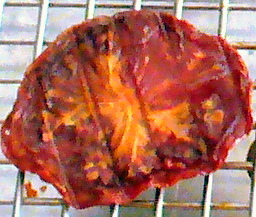 Drying is one of the simplest and least expensive forms of food preservation, requiring only warm temperatures combined with good air circulation. Drying removes the water that bacteria, yeasts, and molds need to grow. If adequately dried and properly stored, dehydrated foods are shelf stable (safe for storage at room temperature). You have a choice of several different methods to dry food. Methods that work well in the most climates include solar drying, conventional ovens, or an electric dehydrator.
Drying is one of the simplest and least expensive forms of food preservation, requiring only warm temperatures combined with good air circulation. Drying removes the water that bacteria, yeasts, and molds need to grow. If adequately dried and properly stored, dehydrated foods are shelf stable (safe for storage at room temperature). You have a choice of several different methods to dry food. Methods that work well in the most climates include solar drying, conventional ovens, or an electric dehydrator.
- Solar drying utilizes a collector, which traps heat and makes it possible to dry foods in any climate. The collector is a specially designed covered box that increases the drying temperature and maximizes air circulation. You can find online articles on solar food drying, including plans for building solar dryers at builditsolar.com.
- Oven drying uses a conventional gas or electric oven. It is a good choice if you want to do occasional drying or are drying for the first time. Caution: the oven-drying method is not safe in a home with small children.
- An electric food-dehydrator can consistently produce a quality product and is easier than other methods. You can purchase a basic model for as little as $50, which is a good choice for first-time users or those who want to dry foods occasionally or in small amounts.
Dried Fruits using a dehydrator
Yield: 1⁄8 to 1⁄3 pound dried per pound of fresh fruit
Ingredients:
2 lb. (about 2 dry pt.) fresh fruit (such as berries, cherries, or figs)
Directions:
- Wash fruit and pick through to choose only fully ripe, unblemished fruit.
- Large strawberries and figs may be halved, quartered, or sliced. Leave other berries whole (such as raspberries and blueberries). Cherries may be pitted or unpitted. Steam-blanch firm-skinned berries and fruits such as blueberries, cherries, and figs to “check” their skins and ensure thorough drying. Pretreat light-colored fruits for browning such as Royal Anne cherries and green figs. Spread on towel lined trays to remove excess moisture.
- Preheat an oven or food dehydrator to 130°F to 140°F. Place fruit on drying trays.
- Dry until shriveled and leathery for snacking, or brittle for longer storage.
- Cool 30 minutes, or until no longer warm. Remove from drying trays. Store in an airtight container in a cool, dry place.
Dried Chopped Vegetables using a dehydrator
Yield: 1⁄8 to 1⁄3 pound dried per pound of fresh vegetables
Ingredients:
- 2 lb. (about 2 dry pt.) fresh vegetables (such as carrots, peas, broccoli, or corn kernels)
Directions:
- Wash vegetables. Peel and trim as needed. Cut in serving-size pieces and steam-blanch to inactivate enzymes and improve storage quality. Spread on towel-lined trays to remove excess moisture.
- Preheat an oven or food dehydrator to 130°F to 140°F. Place vegetables on drying trays. Dry until vegetables are shriveled and leathery, or brittle for longer storage.
- Cool 30 minutes, or until no longer warm. Remove from drying trays. Store in an airtight container in a cool, dry place.
Oven-Dried Tomatoes
Yield: 15 to 20 ounces
Ingredients:
- 15 to 20 (about 5 lb.) medium fresh ripe tomatoes, preferably no larger than 3 inches in diameter
Directions:
- Core, and halve or quarter small tomatoes up to 3 inches in diameter; slice large tomatoes 1⁄8 to 3⁄8 inch thick.
- Preheat oven to the lowest temperature setting. Maintain an oven temperature between 125°F and 145°F. Check the oven temperature with an accurate thermometer. Decrease the temperature by propping open the oven door with a wooden spoon or folded towel.
- Maximize air circulation to speed drying. Place a fan on a chair near the propped-open oven door so that it blows away the hot, escaping air. Open nearby doors and windows to promote more airflow.
- Continue to dry until tomatoes have flattened completely, shrunk greatly in size, deepened in color to a dark red, and are no longer plump or sticky. Dry until pliable, or crisp and brittle for longer storage.
- Cool 30 minutes, or until no longer warm. Remove from drying trays. Store in an airtight container in a cool, dry place.
You might also like:
- An Introduction to the Drying Food Preservation Method
- How to dry melon slices
- Bean and pasta soup recipe with dried vegetables
For information about eight different food preservation methods, including over 300 delicious recipes, get the book The Home Preserving Bible by Carole Cancler, available from booksellers everywhere.




